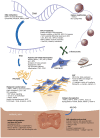Understanding Keloid Pathobiology From a Quasi-Neoplastic Perspective: Less of a Scar and More of a Chronic Inflammatory Disease With Cancer-Like Tendencies
- PMID: 31440236
- PMCID: PMC6692789
- DOI: 10.3389/fimmu.2019.01810
Understanding Keloid Pathobiology From a Quasi-Neoplastic Perspective: Less of a Scar and More of a Chronic Inflammatory Disease With Cancer-Like Tendencies
Abstract
Keloids are considered as benign fibroproliferative skin tumors growing beyond the site of the original dermal injury. Although traditionally viewed as a form of skin scarring, keloids display many cancer-like characteristics such as progressive uncontrolled growth, lack of spontaneous regression and extremely high rates of recurrence. Phenotypically, keloids are consistent with non-malignant dermal tumors that are due to the excessive overproduction of collagen which never metastasize. Within the remit of keloid pathobiology, there is increasing evidence for the various interplay of neoplastic-promoting and suppressing factors, which may explain its aggressive clinical behavior. Amongst the most compelling parallels between keloids and cancer are their shared cellular bioenergetics, epigenetic methylation profiles and epithelial-to-mesenchymal transition amongst other disease biological (genotypic and phenotypic) behaviors. This review explores the quasi-neoplastic or cancer-like properties of keloids and highlights areas for future study.
Keywords: bioenergetics; cancer; epigenetics; fibroproliferative; keloid; quasi-neoplastic; skin scarring; tumor.
Figures
Similar articles
-
Keloid scarring or disease: Unresolved quasi-neoplastic tendencies in the human skin.Wound Repair Regen. 2020 May;28(3):422-426. doi: 10.1111/wrr.12793. Epub 2020 Feb 5. Wound Repair Regen. 2020. PMID: 31943508 Review.
-
Hypertrophic and keloid scars fail to progress from the CD34- /α-smooth muscle actin (α-SMA)+ immature scar phenotype and show gradient differences in α-SMA and p16 expression.Br J Dermatol. 2020 Apr;182(4):974-986. doi: 10.1111/bjd.18219. Epub 2019 Sep 4. Br J Dermatol. 2020. PMID: 31206605
-
Are keloid and hypertrophic scar different forms of the same disorder? A fibroproliferative skin disorder hypothesis based on keloid findings.Int Wound J. 2014 Oct;11(5):517-22. doi: 10.1111/j.1742-481X.2012.01118.x. Epub 2012 Nov 22. Int Wound J. 2014. PMID: 23173565 Free PMC article.
-
Genetics and Epigenetics of Keloids.Adv Wound Care (New Rochelle). 2022 Apr;11(4):192-201. doi: 10.1089/wound.2021.0094. Epub 2021 Dec 27. Adv Wound Care (New Rochelle). 2022. PMID: 34498914
-
Functional histopathology of keloid disease.Histol Histopathol. 2015 Sep;30(9):1033-57. doi: 10.14670/HH-11-624. Epub 2015 Apr 22. Histol Histopathol. 2015. PMID: 25900252 Review.
Cited by
-
Research update of adipose tissue-based therapies in regenerative dermatology.Stem Cell Rev Rep. 2022 Aug;18(6):1956-1973. doi: 10.1007/s12015-022-10328-w. Epub 2022 Mar 1. Stem Cell Rev Rep. 2022. PMID: 35230644 Review.
-
Immune-related gene expression in skin, inflamed and keloid tissue from patients with keloids.Oncol Lett. 2022 Feb;23(2):72. doi: 10.3892/ol.2022.13192. Epub 2022 Jan 5. Oncol Lett. 2022. PMID: 35069881 Free PMC article.
-
Comparing intralesional triamcinolone and verapamil-triamcinolone injections in keloids: A single-blinded randomised clinical trial.Int Wound J. 2023 Dec;20(10):4166-4174. doi: 10.1111/iwj.14314. Epub 2023 Sep 5. Int Wound J. 2023. PMID: 37670475 Free PMC article. Clinical Trial.
-
Vascular and Collagen Target: A Rational Approach to Hypertrophic Scar Management.Adv Wound Care (New Rochelle). 2023 Jan;12(1):38-55. doi: 10.1089/wound.2020.1348. Epub 2021 Aug 10. Adv Wound Care (New Rochelle). 2023. PMID: 34328823 Free PMC article. Review.
-
The HEDGEHOG-GLI1 pathway is important for fibroproliferative properties in keloids and as a candidate therapeutic target.Commun Biol. 2023 Dec 7;6(1):1235. doi: 10.1038/s42003-023-05561-z. Commun Biol. 2023. PMID: 38062202 Free PMC article.
References
Publication types
MeSH terms
LinkOut - more resources
Full Text Sources


